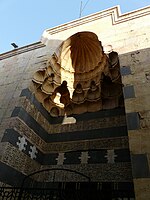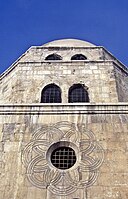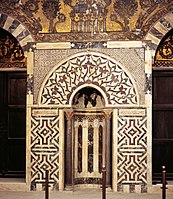Zahiriyya Library
| Zahiriyya Library | |
|---|---|
al-Zahir Baybars (his tomb) | |
| Original use | madrasa, mausoleum |
| Current use | public library |
| Architect | Ibrahim ibn Ghana’im al-Muhandis |
| Architectural style(s) | Mamluk, Islamic |
The Zahiriyya Library (
The funerary complex of al-Zahir Baybars
Background: Sultan al-Zahir Baybars
Sultan
Baybars died unexpectedly in July 1277 in his palace (called al-Qasr al-
The madrasa and mausoleum
Construction of the complex began in 1277 but did not finish until later. It was still unfinished when al-Sa'id died and was buried here in 1280, and the new sultan
Like many subsequent Mamluk foundations, the funerary complex of Baybars served multiple functions, which were outlined in its waqf (trust agreement for charitable foundations under Islamic law). It included two madrasas (teaching Islamic law), a Dar al-Hadith (school for teaching the sayings of the Prophet), and the sultan's mausoleum (called a turba). The complex included a monumental portal with a broad canopy of stone-carved muqarnas (honeycomb or stalactite-like forms) culminating in a shell-like hood, considered one of the most accomplished examples of its kind in Syria.[6] The portal and exterior of the building also demonstrates alternating layers of dark and light stone, known as ablaq masonry. Today, the portal and the mausoleum are the best-preserved historical parts of the complex.[6][9]
The mausoleum is covered by a large dome and its interior is boldly decorated with marble paneling along its lower walls (dadoes) and a large frieze of glass mosaics along its upper walls. The mosaics are reminiscent of the more famous ones found in the Ummayyad Mosque nearby, illustrating scenes of trees and palaces. However, their craftsmanship is of somewhat lesser quality, suggesting that this skill was in decline compared to earlier periods.[6][9][11] The mihrab (a wall niche symbolizing the direction of prayer) also features an elaborate composition of marble mosaic paneling forming geometric and foliated patterns.[6] The muqarnas portal (the earliest example of which is the Bimaristan of Nur al-Din), the marble dadoes, and (to a lesser extent) the mosaic friezes of the mausoleum were decorative elements that would recur throughout the Mamluk period after Baybars.[9]
-
The exterior of the mausoleum's dome.
-
Baybars, with marble mosaic paneling and glass mosaics above.
-
A section of the glass mosaics along the walls of the mausoleum.
The Library
The madrasa had a library from the outset. Its first books were donated by the mother of al-Sa'id Barakah as part of the madrasa's endowment.[5] It was only turned into a "general library" in 1876 or 1877 by Sheikh Tahir al-Jazairi and Salim al-Bukhari, who collected thousands of items for the library.[12] He was helped in part by the governor of Damascus, Midhat Pasha, who used an edict from the Ottoman sultan to collect books from around the region.[12] The library was nationally recognized by the Syrian state and opened to the public in 1880 or 1881.[12] It continued to consolidate collections throughout the late 19th century and early 20th century and became the National Library.[13] It played a part in the Arabic literary renaissance that was ongoing in Syria in that period.[13]
In 1919 the "Arab Academy was charged with the supervision of the al-Zahiriyya Library. … Its collection consisted at that time of the surviving manuscripts from different small libraries in Syria. … The collection grew from 2,465 manuscripts to 22,000 volumes between 1919 and 1945."[14] In 1949 a legal deposit law decreed that two copies of every work published in Syria be deposited in the library. The law was not enforced until July 1983, when a presidential decree required the deposit of 5 copies of each work published by a Syrian author. In 1984 the Al-Assad Library became the Syrian national library, replacing al-Zahiriyah Library.
The manuscript department includes over 13,000 classical
See also
References
- ^ "Madrasa al-Zahiriyya (Damascus)". Archnet. Retrieved 2019-11-13.
- ^ Clot, André (2009). L'Égypte des Mamelouks: L'empire des esclaves 1250-1517. Perrin.
- ^ Saunders, J.J. (2001). The History of the Mongol Conquests. University of Pennsylvania Press.
- ^ a b "Baybars I | Mamlūk sultan of Egypt and Syria". Encyclopedia Britannica. Retrieved 2019-11-15.
- ^ .
- ^ a b c d e f Degeorge, Gérard (2004). Damascus. Flammarion. pp. 107–110.
- ^ a b Burns, Ross (2005). Damascus: A History. Routledge. p. 199.
- ^ Daiber, Verena. "Madrasa al-Zahiriyya". Discover Islamic Art, Museum With No Frontiers. Retrieved November 14, 2019.
- ^ a b c d e Blair, Sheila S.; Bloom, Jonathan (1995). The Art and Architecture of Islam: 1250-1800. New Haven; London: Yale University Press. pp. 71–72.
- ^ Rabat, Nasser O. (1995). The Citadel of Cairo: A New Interpretation of Royal Mamluk Architecture. E.J. Brill.
- ^ Markus, Hattstein; Delius, Peter, eds. (2011). Islam: Art and Architecture. h.f.ullman. p. 192.
- ^ a b c "Damascus' Cultural Heritage: Al-Zahiriyya Library". worldbulletin.net/ (in Turkish). Retrieved 2019-11-15.
- ^ S2CID 133314943– via JSTOR.
- OL 3623623M, 1579582443
- Nahj al-Balagha
- ^ World Guide to Libraries (25th ed.), De Gruyter Saur, 2011
External links
- Madrasa al-Zahiriyya at ArchNet (includes pictures and floor plan)
- Images of the Mausoleum of Baybars, Manar al-Athar digital photo archive




